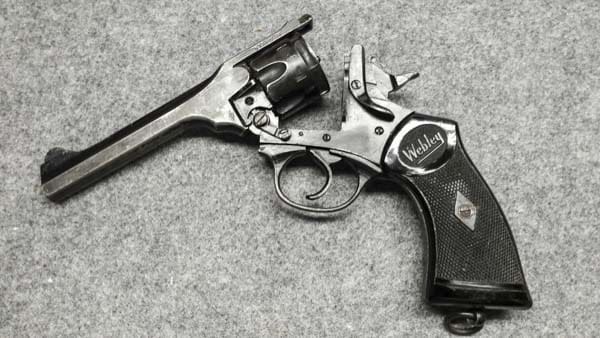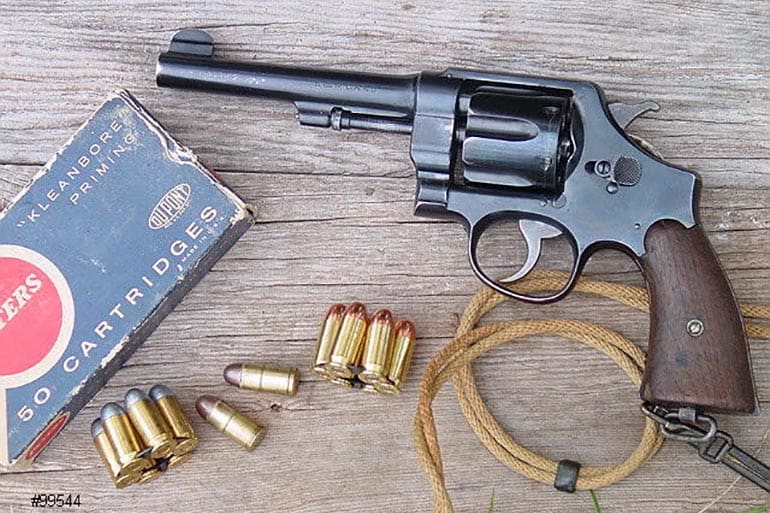By Ben Jimenez
If you grew up reading gun magazines in the 1980s (yes, print media was the only option then), you were frequently bombarded with monthly topics like “9mm vs. .45,” “Rubber vs. Wood Grips,” or the hotly contested “Revolver vs. Semi-auto.”
GLOCK had just released the G17 and some in Congress began speechifying about “undetectable pistols” getting through airport security. The U.S. military had just retired the classic 1911A1 pistol and replaced it with an Italian 9mm “mouse gun.” People were hyperventilating as the sacred cows of the gun world were slain one at a time.
Police departments across the nation began issuing semi-auto pistols, firearms ranging from Beretta 92’s to GLOCK 17’s. Smith & Wesson semi-autos were popular choices, but every cop and handgun-shooting civilian knew how to run a revolver and probably owned one or more.

Flash forward to the 21st century when virtually every police department in the country issues some sort of semi-auto pistol to their officers. The NYPD, who had allowed officers of a certain tenure to keep their .38 Specials, finally retired those officers and their guns in 2018, ending over 120 years of the .38 wheel gun on patrol in the five boroughs.
Many law enforcement officers get their only firearms training through whichever academy is attached to their organization, and that academy only teaches new recruits how to use the firearms their department issues. This maximizes the resources that the academy has and ensures that the freshly minted rookies will be highly qualified with whichever model auto pistol, shotgun or rifle they are issued.
The downside to this is that we now have generations of police patrolling the streets who have never held a revolver and have no idea how to operate one. They often don’t know how to open the cylinder to clear the gun if they run across one in the wild or even check to see if it’s loaded or not.
This problem isn’t limited to police professionals. The pool of civilians capable of training others to use revolvers has dwindled to where it’s becoming a specialized skill that is taught by a handful of instruction sources. Our collective knowledge base has been boiled down to operating a high capacity, polymer framed striker-fired pistol.

And the issue isn’t limited to revolvers. If you’re an armed professional or a civilian who carries a handgun for personal defense, you need to know how to run the majority of the guns you might run across.
Why? Because you may find yourself having to use the gun you wrestled out of the hand of an assailant. Or use one that’s handed to you by a neighbor. Or you may need to clear a gun on a scene, or in an attic or garage.
If you have prepared yourself in the ways of armed self-defense, you need to know how to utilize the tools at hand, even if they’re not the most modern or ideal. A 100-year-old gun with one round in it can still kill you as dead as one that rolled off the assembly line yesterday.

What types of pistols might you encounter? Depending on where you live, it may be a single action revolver, a double action revolver or a break top revolver. It might be a steel-framed, single action 1911 in .45ACP or a Browning High Power in 9mm.

It could be a High Standard Derringer in .22 Magnum or a Bond Arms in .45LC. These are sometimes found with “wallet holsters” meant to disguise the gun and are only legal for law enforcement after the ATF reclassified any gun equipped with one.
You might need to run a Smith & Wesson DA/SA Model 59 or a Beretta 92/M9. Do you know where the safety/de-cocker is? Which direction means “fire?” (On a DA/SA with slide mounted safety, point the safety in the direction you want the bullets to go–forward = out the front, down = stay in the gun).
It could be a European version of a gun you’re familiar with but it has a heel-type magazine release.

Going through grandpa’s old trunk? Is that a German Luger in there? Did he bring back a Broomhandle Mauser C-95? Can you tell if it’s loaded or not without pulling the trigger?

Did your partner just hand you her backup Smith J-frame .38 with a spare speed strip when you dropped your GLOCK down the sewer grate or you ran out of ammo? What the heck do you do with that?
What if you just saw a cop get shot and the perpetrator took their gun. Do you know where to check them for a backup weapon? An ankle holster, vest holster, pocket holster or IWB holster could contain the gun you need in that situation. Would you know how to run what you find? A J-frame or a Walther PPK?
There are resources to help you gain the knowledge you need. The National Rifle Association is the nation’s leading resource for firearms training. They have a number of classes that can expose you to a variety of firearm types.
If you are “on the job,” see if your department has a firearms unit or shooting team. These frequently attract the firearm experts in an organization who would be more than happy to share their knowledge. Also, try your local gun shop, especially if you are considering the purchase of a concealed carry or backup gun.
Until recently, Youtube.com had been an outstanding source of obscure firearm information. While they are in the process of running off anything firearms-related, you can still find videos on the internet that can introduce you to the world of metal guns. The Military Arms Channel and Forgotten Weapons can show some really obscure designs, but also cover items that you may run into on the street.
Whether your job is patrolling Chinatown or making sure your kids make it to the bus stop safely, if you carry a gun, you should also arm yourself with the knowledge to operate any gun that may come within your sphere of influence. If you need it to shoot or you need it to not shoot, it’s a safety issue that could mean life and death for you or a loved one.







